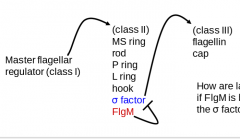![]()
![]()
![]()
Use LEFT and RIGHT arrow keys to navigate between flashcards;
Use UP and DOWN arrow keys to flip the card;
H to show hint;
A reads text to speech;
16 Cards in this Set
- Front
- Back
|
Capsules |
- repel viruses - repel hydrophobic antimicrobial compounds - attaches to host tissues - protects against phagocytosis - protects against dessication - participates in biofilm formation |
|
|
Bacterial Flagella |
enables cell to swim thru fluid * mvmt is similar to boat propeller * |
|
|
Flagella Experiment |
Tethered E. coli: - end of flagellum attached to slide using an antibody - as flagellar motor turns, we see body rotate |
|
|
Stator |
Does not rotate: -MotA -MotB |
|
|
Rotor |
Rotates: -Rod -Hook -Filament |
|
|
Flagellar Structure |
MS Ring: anchor in cytoplasmic membrane P Ring: anchor in PG L Ring: anchor in outer membrane C Ring: function in export of flagellar proteins & switching direction of rotation |
|
|
Building Blocks of Flagella |
- Base built inside out BUT flagellan monomers are added at far end of filament under the cap - Early proteins secreted into the membrane using SecYEG pathway - Later proteins secreted thru channel in axis of rod/ hook/ filament |
|
|
Transcriptional cascade |

sigma factor leads to expression FlgM blocks sigma factor |
|
|
how do late genes get transcribed if FlgM blocks sigma factor? |
when basal-body hook is complete, FlgM is exported via flagellar channel allowing sigma factor to promote transcription of flagellin and cap |
|
|
Conjugation Systems |
Combo of pilus and secretion system F pilus attaches to recipient cell and forms channel or DNA transfer --> transports proteins + DNA |
|
|
Type IV Pili |
- extend & retract--> used for surface motility - subunits are very hydrophobic - proteins exported via Sec system |
|
|
Type I Pili |
- used exclusively for attachment - no retraction |
|
|
Type II Secretion System |
- Related to Type 4 pili (gliding across surfaces) - Transfers proteins - Secretes proteins into extracellular space - Substrates use Sec system to get to periplasm |
|
|
Type III Secretion System |
- Related to flagellum (swimming in liquid) - Transfers proteins - Secretes proteins into host cell cytoplasm - Substrates DON'T use Sec system |
|
|
Type IV Secretion System |
- Related to conjugational pili - transfers proteins +/- DNA - secretes substrates into host cyto or extracellular space - Substrates SOMETIMES use Sec system |
|
|
Type VI Secretion System |
-Related to contractile phage tails - Transfers proteins - Secretes substrates into cyto of host cell or other bacteria - Substrates DON'T use Sec system |

